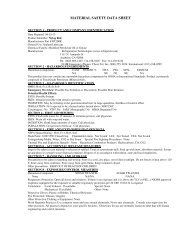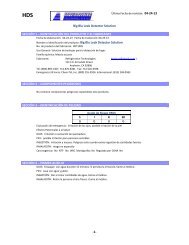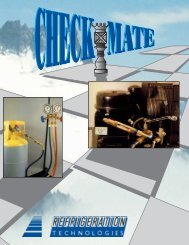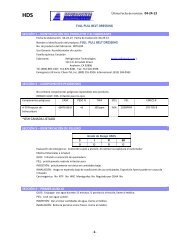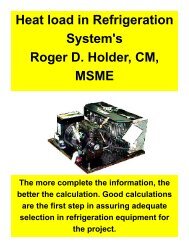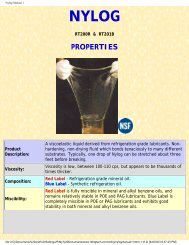Balancing of a Water and Air System (PDF
Balancing of a Water and Air System (PDF
Balancing of a Water and Air System (PDF
Create successful ePaper yourself
Turn your PDF publications into a flip-book with our unique Google optimized e-Paper software.
62<br />
Flow Tolerance <strong>and</strong> Balance Procedure<br />
The design procedure rests on a design flow rate <strong>and</strong> an allowable flow tolerance. The<br />
designer must define both the terminal’s flow rates <strong>and</strong> feasible flow tolerance,<br />
remembering that the cost <strong>of</strong> balancing rises with tightened flow tolerance. Any overflow<br />
increases pumping cost, <strong>and</strong> any flow decrease reduces the maximum heating or cooling<br />
at design conditions.<br />
WATER-SIDE BALANCING<br />
<strong>Water</strong>side balancing adjustments should be made with a thorough underst<strong>and</strong>ing <strong>of</strong><br />
piping friction loss calculations <strong>and</strong> measured system pressure losses. It is good<br />
practice to show expected losses <strong>of</strong> pipes, fittings, <strong>and</strong> terminals <strong>and</strong> expected<br />
pressures in operation on schematic system drawings.<br />
The waterside should tested by direct flow measurement. This method is accurate<br />
because it deals with system flow as a function <strong>of</strong> differential pressures, <strong>and</strong> avoids<br />
compounding errors introduced by temperature difference procedures. Measuring flow at<br />
each terminal enables proportional balancing <strong>and</strong>, ultimately, matching pump head <strong>and</strong><br />
flow to actual system requirements by trimming the pump impeller or reducing pump<br />
motor power. Often, reducing pump-operating cost will pay for the cost <strong>of</strong> waterside<br />
balancing.<br />
Equipment<br />
Proper equipment selection <strong>and</strong> preplanning are needed to successfully balance<br />
hydronic systems. Circumstances sometimes dictate that flow, temperature, <strong>and</strong><br />
pressure be measured. The designer should specify the water flow balancing devices for<br />
installation during construction <strong>and</strong> testing during hydronic system balancing. The<br />
devices may consist <strong>of</strong> all or some <strong>of</strong> the following:<br />
• Flow meters (ultrasonic stations, turbines, venturi, orifice plate, multiported pitot tubes,<br />
<strong>and</strong> flow indicators)<br />
• Manometers, ultrasonic digital meters, <strong>and</strong> differential pressure gages (analog or<br />
digital)<br />
• Portable digital meter to measure flow <strong>and</strong> pressure drop<br />
• Portable pyrometers to measure temperature differentials when test wells are not<br />
provided<br />
• Test pressure taps, pressure gages, thermometers, <strong>and</strong> wells.<br />
• <strong>Balancing</strong> valve with a factory-rated flow coefficient Cv, a flow versus h<strong>and</strong>le position<br />
<strong>and</strong> pressure drop table, or a slide rule flow calculator<br />
• Dynamic balancing valves or flow-limiting valves (for pre-balanced systems only); field<br />
62




